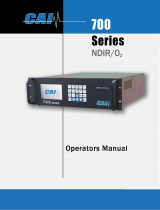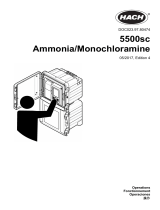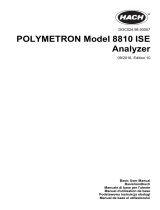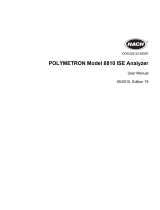Page is loading ...

Teledyne Analytical Instruments
OPERATING INSTRUCTIONS FOR
Model 6750
Total Organic Carbon Analyzer
DANGER
Toxic gases and or flammable liquids may be present in this monitoring system.
Personal protective equipment may be required when servicing this instrument.
Hazardous voltages exist on certain components internally which may persist
for a time even after the power is turned off and disconnected.
Only authorized personnel should conduct maintenance and/or servicing.
Before conducting any maintenance or servicing, consult with authorized
supervisor/manager.
P/N M
ECO:

Model 6750
Teledyne Analytical Instruments ii
Copyright © 2005 Teledyne Instruments/ Analytical Instruments
All Rights Reserved. No part of this manual may be reproduced, transmitted, transcribed,
stored in a retrieval system, or translated into any other language or computer language in
whole or in part, in any form or by any means, whether it be electronic, mechanical,
magnetic, optical, manual, or otherwise, without the prior written consent of Teledyne
Instruments/ Analytical Instruments, 16830 Chestnut Street, City of Industry, CA 91749-
1580.
Warranty
This equipment is sold subject to the mutual agreement that it is warranted by us free from
defects of material and of construction, and that our liability shall be limited to replacing or
repairing at our factory (without charge, except for transportation), or at customer plant at
our option, any material or construction in which defects become apparent within one year
from the date of shipment, except in cases where quotations or acknowledgements provide
for a shorter period. Components manufactured by others bear the warranty of their
manufacturer. This warranty does not cover defects caused by wear, accident, misuse,
neglect or repairs other than those performed by TI/AI or an authorized service center. We
assume no liability for direct or indirect damages of any kind and the purchaser by the
acceptance of the equipment will assume all liability for any damage which may result from
its use or misuse.
We reserve the right to employ any suitable material in the manufacture of our apparatus,
and to make any alterations in the dimensions, shape or weight of any parts, in so far as
such alterations do not adversely affect our warranty.
Important Notice
This instrument provides measurement readings to its user, and serves as a tool by which
valuable data can be gathered. The information provided by the instrument may assist the user
in eliminating potential hazards caused by his process; however, it is essential that all
personnel involved in the use of the instrument or its interface, with the process being
measured, be properly trained in the process itself, as well as all instrumentation related to it.
The safety of personnel is ultimately the responsibility of those who control process
conditions. While this instrument may be able to provide early warning of imminent
danger, it has no control over process conditions, and it can be misused. In particular, any
alarm or control systems installed must be tested and understood, both as to how they
operate and as to how they can be defeated. Any safeguards required such as locks, labels,
or redundancy, must be provided by the user or specifically requested of TI/AI at the time
the order is placed.
Therefore, the purchaser must be aware of the hazardous process conditions. The purchaser
is responsible for the training of personnel, for providing hazard warning methods and
instrumentation per the appropriate standards, and for ensuring that hazard warning devices
and instrumentation are maintained and operated properly.
Teledyne Instruments/ Analytical Instruments, the manufacturer of this instrument, cannot
accept responsibility for conditions beyond its knowledge and control. No statement
expressed or implied by this document or any information disseminated by the
manufacturer or its agents, is to be construed as a warranty of adequate safety control under
the user’s process conditions.

Total Organic Carbon Analyzer
Teledyne Analytical Instruments iii
Specific Model Information
Instrument Serial Number: _______________________
Instrument Range: _______________
Calibrated for: _______________
Background Gas: _______________
Zero Gas: _______________
Span Gas: _______________

Model 6750
Teledyne Analytical Instruments iv
Safety Messages
Your safety and the safety of others is very important. We have
provided many important safety messages in this manual. Please read
these messages carefully.
A safety message alerts you to potential hazards that could hurt you
or others. Each safety message is associated with a safety alert symbol.
These symbols are found in the manual and inside the instrument. The
definition of these symbols is described below:
GENERAL WARNING/CAUTION: Refer to the
instructions for details on the specific danger. These cautions
warn of specific procedures which if not followed could cause
bodily Injury and/or damage the instrument.
CAUTION: HOT SURFACE WARNING: This warning is
specific to heated components within the instrument. Failure
to heed the warning could result in serious burns to skin and
underlying tissue.
WARNING: ELECTRICAL SHOCK HAZARD: Dangerous
voltages appear within this instrument. This warning is
specific to an electrical hazard existing at or nearby the
component or procedure under discussion. Failure to heed this
warning could result in injury and/or death from
electrocution.
Technician Symbol: All operations marked with this symbol
are to be performed by qualified maintenance personnel only.
NOTE: Additional information and comments regarding a
specific component or procedure are highlighted in the form
of a note.
CAUTION: THE ANALYZER SHOULD ONLY BE USED FOR THE
PURPOSE AND IN THE MANNER DESCRIBED IN
THIS MANUAL.
No
Symbol

Total Organic Carbon Analyzer
Teledyne Analytical Instruments v
IF YOU USE THE ANALYZER IN A MANNER OTHER
THAN THAT FOR WHICH IT WAS INTENDED,
UNPREDICTABLE BEHAVIOR COULD RESULT
POSSIBLY ACCOMPANIED WITH HAZARDOUS
CONSEQUENCES.
This manual provides information designed to guide you through
the installation, calibration operation and maintenance of your new
analyzer. Please read this manual and keep it available.
Occasionally, some instruments are customized for a particular
application or features and/or options added per customer requests.
Please check the front of this manual for any additional information in
the form of an Addendum which discusses specific information,
procedures, cautions and warnings that may be peculiar to your
instrument.
Manuals do get lost. Additional manuals can be obtained from
TI/AI at the address given in the Appendix. Some of our manuals are
available in electronic form via the internet. Please visit our website at:
www.teledyne-ai.com.

Model 6750
Teledyne Analytical Instruments vi
Table of Contents
List of Figures.............................................................................. ix
List of Tables ............................................................................... xi
Introduction .................................................................................. 1
1.1 Main Features of the Analyzer 1
1.2 Options 2
1.3 Typical Applications 2
1.4 Intended Use of the Analyzer 2
1.5 Operator Interface 3
Theory of Operation ..................................................................... 5
2.1 Overview 5
2.2 Background 5
2.3 The UV/Heated Persulfate Method of Analysis 9
2.4 Subsystems Principles of Operation 11
2.4.1 Sample Handling 11
2.4.1.1 Liquid Phase Sample Handling 11
2.4.2.2 Gas Phase Sample Handling 13
2.4.2 Inorganic Carbon Removal/Analysis 14
2.4.3 Oxidation 15
2.4.4 NDIR CO
2
Gas Detection 17
2.4.5 Electronic Signal Processing, Display and Control 18
2.4.5.1 Benchmark/Auto-Validation 19
2.4.5.2 Auto-Calibration 19
2.4.5.3 Auto-Cleaning 19
Installation .................................................................................. 21
3.1 Unpacking the Analyzer 21
3.2 Mounting the Analyzer 21

Total Organic Carbon Analyzer
Teledyne Analytical Instruments vii
3.3 Electrical Connections 23
3.3.1 Power Connection 23
3.3.2 Analog Outputs 24
3.3.3 Alarm Connections 25
3.3.4 RS-232 Serial Connection 25
3.4 Gas/liquid Connections 25
3.4.1 Liquid Connections 25
3.4.2 Gas Connections 26
3.5 Checking the System 27
Setup and Operation...................................................................29
4.1 Analyzer Startup 29
4.2 Menus 31
4.2.1 Run Mode 31
4.2.2 Parameter Menu 32
4.2.3 Alarm Settings 33
4.2.4 Stream Sequencer 34
4.2.5 D/DBPR 35
4.3 Detailed Calibration Procedures 36
4.4 Operation 40
4.5 Shutdown 41
4.6 Historical Data 41
Maintenance ................................................................................43
5.1 Compupter-aided Testing 43
5.2 Troubleshooting 44
5.3 Module Service 45
5.3.1 NDIR (Gas Calibration) 45
5.3.2 NDIR Service 47
5.3.3 Master Interface Board (P/N ST13042-1). 53
5.3.4 D. C. Power Supply 54
5.3.5 CE Computer (P/N 13039) 55
5.3.6 UV Lamp (P/N ST20009) 56
5.3.7 UV Reactor Assembly (P/N ST20003-1) 57

Model 6750
Teledyne Analytical Instruments viii
5.3.8 UV Power Supply 58
5.3.9 Mass Flow Controller (P/N ST18001A) 59
5.3.10 Metering Valve (P/N ST16050) 60
5.3.11 Sparger (P/N ST20025) 61
5.3.12 Pumps 63
5.3.12.1 Pump Motor Replacement 63
5.3.12.2 Pump Head Tubing Replacement 65
5.3.13 4-20 mA Adjustment Procedure 67
5.3.13.1 Setting 100 mV Control Voltage 68
5.3.13.2 Setting of 4-20 mA output 68
Appendix..................................................................................... 69
A.1Specifications 69
A.2 Parts Listing 71
A.3 Options 76
A.3.1 Option 200008 76
A.3.2 Option 200009 76
A.3.3 Option 200010 76
A.3.4 Option 200016 77
A.3.5 Option 200017 77
A.3.6 Option 200009 77
A.3.7 Option 400008 77
A.3.8 Option 200026 77
A.4 AS-BUILT Drawings 79
Index............................................................................................ 81

Total Organic Carbon Analyzer
Teledyne Analytical Instruments ix
List of Figures
Figure 1-1: The Model 6750 TOC Analyzer (Front door removed) . 3
Figure 2-1: NPOC or TOC – Direct Method.................................... 6
Figure 2-2: TOC – True Method ..................................................... 6
Figure: 2-3: TOC Measurement Basics .......................................... 8
Figure 2-4: UV/Persulfate Method .................................................. 8
Figure 2-5: Comparison of TOC Measurement Technologies........10
Figure 2-6: Sample Handling for TOC -Direct................................12
Figure 2-7: Sample Handling TOC-True........................................13
Figure 2-8: Relationship Between TIC and pH ..............................15
Figure 2-9: Oxidation Reactions ....................................................16
Figure 2-10: Model 6750 NDIR Unit ..............................................17
Figure 3-1: Analyzer Dimensions ..................................................22
Figure 3-2: Required Door Clearance ...........................................22
Figure 3-3: Internal Components of the Model 6750 Analyzer.......23
Figure 3-4: Electrical Connections to the Model 6750 ...................24
Figure 3-5: Gas and Liquid Connections to the Analyzer...............26
Figure4-1: Drain Connections ......................................................30
Figure 4-2: Gas Liquid Separator D. I. Filling ................................31
Figure 4-3: The RUN Screen.........................................................40
Figure 5-1: Disconnecting Tubing from Reactor ............................46
Figure 5-2: IR Calibration Adapter P/N ST20026...........................46
Figure 5-3: Installing Calibration Adapter ......................................47
Figure 5-4: Removing the NDIR Unit P/N ST 36000......................48
Figure 5-5: Removing the Master Interface Board.........................53

Model 6750
Teledyne Analytical Instruments x
Figure 5-6: DC Power Supply Module........................................... 54
Figure 5-7: Replacing CE Computer ............................................. 55
Figure 5-8: UV Lamp Replacement .............................................. 56
Figure 5-9: Removing the UV Reactor Assembly.......................... 57
Figure 5-10: Removing the UV Power Supply............................... 59
Figure 5-11: Mass Flow Controller................................................ 60
Figure 5-12: Metering Valve ......................................................... 61
Figure 5-13: Sparger .................................................................... 62
Figure 5-14: Removing the Pump ................................................ 65
Figure 5-15: Pump Head Tubing Replacement............................. 67

Total Organic Carbon Analyzer
Teledyne Analytical Instruments xi
List of Tables
Table 4-1: Preparation of Standards (TOC/TIC)............................37
Table 5-1: Troubleshooting ...........................................................44

Model 6750
Teledyne Analytical Instruments xii
DANGER
COMBUSTIBLE GAS USAGE
WARNING
This is a general purpose instrument designed for use in a
non-hazardous area. It is the customer's responsibility to
ensure safety especially when combustible gases are being
analyzed since the potential of gas leaks always exist.
The customer should ensure that the principles of operating
this equipment are well understood by the user. Misuse of
this product in any manner, tampering with its components,
or unauthorized substitution of any component may
adversely affect the safety of this instrument.
Since the use of this instrument is beyond the control of
Teledyne Instruments/ Analytical Instruments, referred as
TI/AI, no responsibility by TI/AI, its affiliates, and agents for
damage or injury from misuse or neglect of this equipment is
implied or assumed.

Total Organic Carbon Analyzer Introduction
Teledyne Analytical Instruments 1
Introduction
Teledyne Model 6750 Total Organic Carbon Analyzer provides
accurate and reliable on-line TOC analysis with Windows™ CE
Operation, using the UV/Heated Persulfate Oxidation Method.
This manual includes all necessary information to help you install,
operate and service your Analyzer.
The Model 6750 TOC Analyzers have been designed for easy
operation and maintenance. Particular attention has been devoted to the
design, whereby any module can be replaced by the operator within 15
minutes. Components such as the NDIR unit have been specifically
designed with no moving parts and use a corrosion resistant design to
further reduce maintenance tasks.
Operating the analyzer is easy. It uses a standard, industrial
Windows CE computer programmed for complete automatic control
(there are no operator manual adjustments). Operators are advised to
study pertinent chapters in this manual to fully utilize the capabilities of
the analyzer and avoid problems that could be associated with any
instrument. The Model 6750 TOC is shown in Figure 1-1.
1.1 Main Features of the Analyzer
The Model 6750 TOC Analyzer is sophisticated, yet simple to use.
The main features of the analyzer include:
• TC (Total Carbon) analysis
• NPOC (Non-purgeable organic carbon) analysis
• TOC-True Analysis (including volatile organics)
• Microsoft Windows Touch Screen Computer with Paperless
Chart Recorder
• Two alarm levels
• One Master Fault Alarm
• 3 analog 4-20 mA outputs

Introduction Model 6750
Teledyne Analytical Instruments 2
• RS-232C and RS-485 outputs
• Separate electronics and liquid compartments
1.2 Options
The following options are available for the Model 6750 TOC
Analyzer and are described in Appendix A.3:
• Correlated BOD/COD
• Dual NDIR Analyzers
• Benchmark/Auto Validation
• Auto-Cal/Auto-Clean
• Automatic Multi-Range
• Multi-Stream Analysis
• DBPR Drinking Water
1.3 Typical Applications
With excellent TOC accuracy from low parts-per-million to high
concentration levels of salt-free samples, the Model 6750 is used in a
variety of applications including:
Boiler Feedwater
Standard Method 5310 C/D Cooling Water
EPA 415.1 Drinking Water
EPA 9060 Wastewater (limited)
ASTM D 4839-88 River Water
ASTM D 4779-88 Oil in Water
1.4 Intended Use of the Analyzer
The Analyzer is exclusively designed for monitoring of Total
Organic Carbon (TOC) in water. This intended use involves carefully
following the instructions provided in this manual and observing all
indicated warnings, hints and instructions.

Total Organic Carbon Analyzer Introduction
Teledyne Analytical Instruments 3
All other types of usage beyond the intended use stated above, are
considered as misuse of the analyzer. The supplier assumes no
responsibility for damage incurred as the result of misuse of the product.
1.5 Operator Interface
The Model 6750 Analyzer is housed in a rugged metal case and
may be wall or rack mounted for operator convenience.
The enclosure is equipped with a viewing window on the front
panel and all operator serviceable components may be viewed through
the cabinet window, including the display.
Figure 1-1: The Model 6750 TOC Analyzer (Front door removed)
All operations are automatic and are performed using the Windows
Touch Screen Computer.

Introduction Model 6750
Teledyne Analytical Instruments 4

Total Organic Carbon Analyzer Theory of Operation
Teledyne Analytical Instruments 5
Theory of Operation
2.1 Overview
The Model 6750 Analyzer uses the UV/Heated Persulfate method
of analysis and is well-suited for many applications involving accurate
TOC analysis. The basic analyzer is configured for maximum utility
using an advanced Microsoft
™
Windows-based CE computer with touch
screen. The analyzer is suitable for both general purpose and/or
hazardous area classifications, if properly configured with required
safety equipment.
2.2 Background
TOC analysis is the primary screening tool and control parameter
for all water based applications but there are some discrepancies or
misunderstanding in just what TOC is comprised of.
Many manufacturers claim TOC analysis capability without
disclosing the limitations of their methods. Some treat all “TOC
analyzers” as a commodity, with no distinguishing characteristics among
them. Analytical results reported by the user can therefore be
questionable, unless the TOC method is matched to the analytical
requirement.
The following discussion is intended to provide the user adequate
information in order to allow intelligent cost/performance trade-offs and
select the appropriate TOC method for each application. The Model 6750
TOC Analyzer performs the following analyses on the SAME sample:
• TC: Total Carbon
• NPOC: Non-Purgeable Organic Carbon
• TIC: Total Inorganic Carbon
• POC (VOC): Purgeable Organic Carbon or Volatile Organic
Carbon
• TOC-True : Total Organic Carbon

Theory of Operation Model 6750
Teledyne Analytical Instruments 6
To perform correct TOC analysis, the analysis system must be
capable of measuring all constituents of organic carbon present in the
sample: Non-Purgeable Organic Carbon (NPOC) and Purgeable
Organic Carbon (POC). Correct TOC analysis must also exclude the
Total Inorganic Carbon (TIC) interference.
Figure 2-1 is a basic, commonly used technique to measure the
NPOC, sometimes referred to as “TOC-Direct”.
Figure 2-1: NPOC or TOC – Direct Method
In this method, acid is added to the sample, lowering its pH to
approximately 2.0, at which point the carbonates present in the sample are
converted to dissolved CO
2
. In the sparger, the carrier gas strips (sparges)
the CO
2
converted from the TIC and vents it, along with any purgeable
(volatile) organics, leaving only NPOC in the sample. The resultant NPOC
is then oxidized to CO
2
in the reactor and measured by the CO
2
detector as
NPOC in the sample, often referred to and reported erroneously as “TOC”.
In Figure 2-2 a preferred method of performing a “TOC- True”
analysis is shown.
Figure 2-2: TOC – True Method
In this case, acid is added to the sample, lowering its pH to
approximately 2.0, at which point the carbonates present in the sample
are converted to dissolved CO
2
. In the sparger, the carrier gas strips

Total Organic Carbon Analyzer Theory of Operation
Teledyne Analytical Instruments 7
(sparges) the CO
2
converted from the TIC and it is measured by an
independent CO
2
detector as “TIC”. POC is also stripped from the
sample in the sparger as HC, but the HC is undetected by the CO
2
detector and does not interfere with the TIC measurement.
A portion of the same sample is also directed to the oxidation
reactor, where inorganic and all organic carbon is converted to CO
2
and
detected by a second CO
2
detector as “Total Carbon”.
A mathematical subtraction of the TIC from the TC measurement
yields a complete, Total Organic Carbon analysis performed as a “TOC-
True” method.
TOC - True = TC - TIC
The difference between the Model 6750’s TOC-True Method
and other simple (TC-TIC) subtraction methods is that most other
simple TC-TIC subtraction methods only deal with a TC measurement,
then a separate TIC measurement and a simple mathematical difference
to derive a “TOC” analysis.
In the TOC-True method used by the Model 6750, the analyzer
actually performs both TC and TIC measurements simultaneously and
continuously on the same sample. The TOC Measurement Basics and
Methods are illustrated in Figures 2-3 and 2-4.
In conclusion:
1. NPOC is the preferred method if no POC/VOC is present
in the sample.
2. TOC-True is the preferred method if POC/VOC exists in
the sample and a TOC analysis is desired which includes
all organic carbon species, for a TOTAL Organic Carbon
measurement.

Theory of Operation Model 6750
Teledyne Analytical Instruments 8
Figure: 2-3: TOC Measurement Basics
Figure 2-4: UV/Persulfate Method
/
















